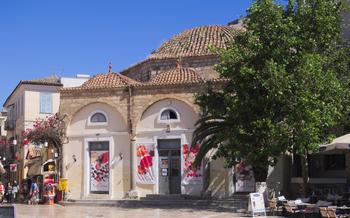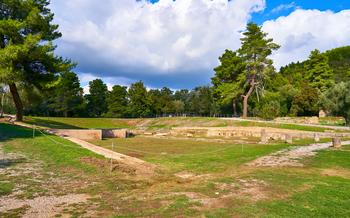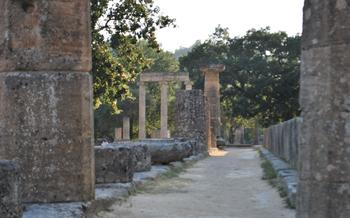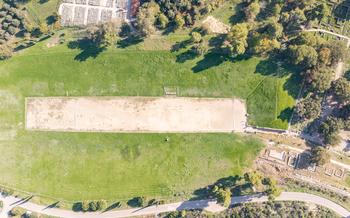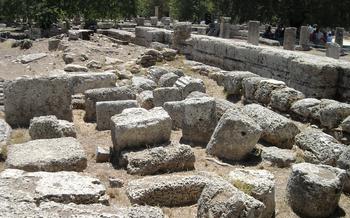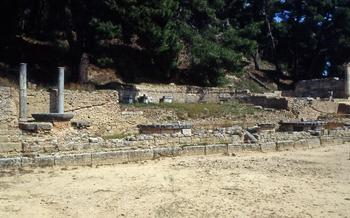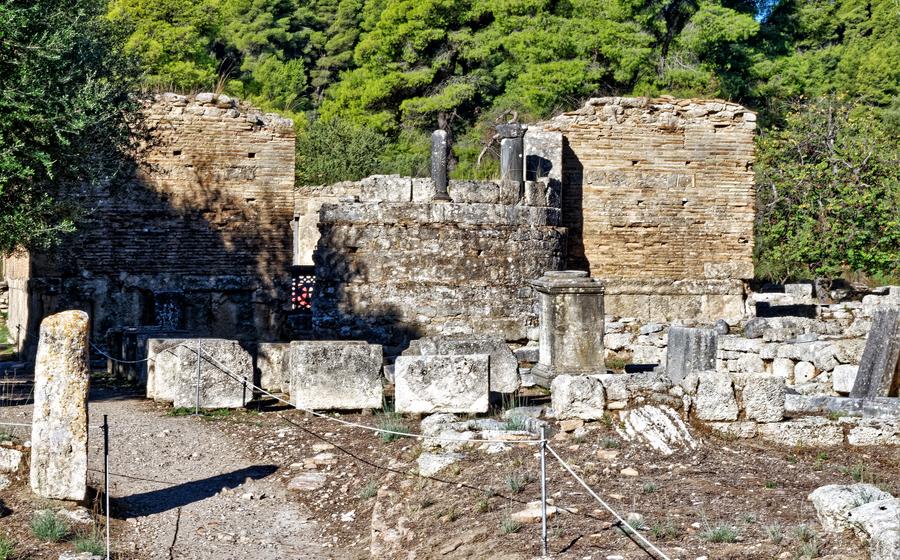
Arkoudorema (Bear’s Stream)
- History of the Arkoudorema (Bear’s Stream)
- Location of the Arkoudorema (Bear’s Stream)
- Main Features of the Arkoudorema (Bear’s Stream)
- Mythology and Legends of the Arkoudorema (Bear’s Stream)
- Religious Significance of the Arkoudorema (Bear’s Stream)
- Excavations at the Arkoudorema (Bear’s Stream)
- Artifacts Found at the Arkoudorema (Bear's Stream)
- The Bear Cult at the Arkoudorema (Bear’s Stream)
- Architecture of the Arkoudorema (Bear’s Stream)
- The Natural Setting of the Arkoudorema (Bear’s Stream)
- Visiting the Arkoudorema (Bear’s Stream)
- Nearby Attractions and Activities
- Accommodation and Dining Options
- Events and Festivals
- Insider Tip
History of the Arkoudorema (Bear’s Stream)
The Arkoudorema (Bear’s Stream) sanctuary, nestled in the enchanting Peloponnese region of Greece, boasts a rich and captivating history that dates back to the depths of antiquity. In the 6th century BC, this sacred site was established as a sanctuary dedicated to the worship of Artemis, the revered goddess of the hunt, nature, and childbirth, whose presence has left an enduring legacy upon the land.
Archaeological excavations conducted at the site have unearthed an array of significant discoveries, including an impressive temple dedicated to Artemis, numerous votive offerings, and a remarkable collection of artifacts that provide valuable insights into the religious practices and beliefs of ancient Greece. These findings have shed light on the sanctuary's profound importance as a center of religious devotion and pilgrimage in the ancient world.
Location of the Arkoudorema (Bear’s Stream)
The Arkoudorema (Bear’s Stream) sanctuary is situated in the enchanting Peloponnese region of Greece, a land steeped in ancient history and natural beauty. Nestled amidst the picturesque village of Nemea, the sanctuary lies approximately 12 kilometers northeast of the city of Argos. Its strategic location at the foot of Mount Apesas offers breathtaking views of the surrounding landscape, characterized by rolling hills, lush forests, and fertile valleys.
The Arkoudorema sanctuary's proximity to other significant archaeological sites further enhances its allure. Just a short distance away, visitors can explore the renowned Nemea Archaeological Museum, home to a wealth of artifacts and exhibits showcasing the region's rich history. Additionally, the ancient city of Mycenae, with its iconic Lion Gate and Treasury of Atreus, is within easy reach, inviting travelers to delve deeper into the captivating world of ancient Greece.
The natural surroundings of the Arkoudorema sanctuary contribute to its serene and evocative atmosphere. The site is enveloped by a dense forest, providing a tranquil retreat from the bustling modern world. Towering trees, vibrant foliage, and the gentle sound of a babbling brook create a symphony of sights and sounds that transport visitors back in time. The sanctuary's integration with the natural environment evokes a sense of harmony and reverence, mirroring the ancient Greeks' deep connection with the natural world.
Main Features of the Arkoudorema (Bear’s Stream)
The Arkoudorema sanctuary is a fascinating and unique site, boasting several notable features that set it apart from other ancient Greek sanctuaries. The sanctuary's central structure is a large, rectangular enclosure surrounded by a massive stone wall. Within this enclosure lies a series of smaller, individual sanctuaries dedicated to various deities. Each of these smaller sanctuaries features its own altar, where worshippers would make offerings and perform rituals.
One of the most striking features of the Arkoudorema sanctuary is its impressive architectural style. The sanctuary's walls are constructed from massive blocks of stone, some of which weigh several tons. The walls are also adorned with intricate carvings and reliefs depicting various mythological scenes and figures. These carvings provide valuable insights into the beliefs and practices of the ancient Greeks who worshipped at the sanctuary.
Another unique characteristic of the Arkoudorema sanctuary is its natural setting. The sanctuary is situated in a lush, forested valley, surrounded by towering mountains and sparkling streams. The natural beauty of the surroundings creates a sense of tranquility and awe, making it an ideal place for religious contemplation and worship.
Mythology and Legends of the Arkoudorema (Bear’s Stream)
The Arkoudorema (Bear’s Stream) is steeped in ancient Greek mythology and legends. One of the most famous myths associated with the site is the story of Heracles (Hercules) and the Erymanthian Boar. According to legend, Heracles was sent by Eurystheus, king of Tiryns, to capture the Erymanthian Boar, a gigantic and ferocious creature that was terrorizing the region of Arcadia. Heracles tracked the boar to the Arkoudorema, where he fought and eventually subdued the beast. The sanctuary's name, Arkoudorema, is derived from this myth, as "arkouda" means "bear" in Greek.
Beyond the myth of Heracles, the Arkoudorema was also associated with the goddess Artemis, who was often depicted with a bear as her companion. Artemis was worshipped as the protector of wild animals and the hunt, and the sanctuary may have been dedicated to her in this capacity. The presence of bear bones and other animal remains at the site further supports the connection to Artemis and her role as a protector of the natural world.
Religious Significance of the Arkoudorema (Bear’s Stream)
The Arkoudorema (Bear’s Stream) sanctuary held great religious importance in ancient Greek religion. It was dedicated to Artemis, the goddess of the hunt, nature, and childbirth. Artemis was highly revered in the region, and the sanctuary served as a center for her worship.
Religious rituals and ceremonies were regularly held at the sanctuary. Devotees would gather to offer sacrifices, prayers, and libations to Artemis. The sanctuary was also a place for pilgrims to seek guidance and blessings from the goddess.
The Arkoudorema sanctuary's religious significance extended beyond the worship of Artemis. It was also associated with the myth of Heracles and the Erymanthian Boar. According to the myth, Heracles was tasked with capturing the ferocious boar that was terrorizing the area. Heracles successfully completed the task and brought the boar back to the sanctuary as an offering to Artemis.
The sanctuary's location amidst a natural setting further enhanced its religious significance. The ancient Greeks believed that sacred places were often found in close proximity to nature. The presence of the bear, a powerful and revered animal in Greek mythology, added to the sanctuary's sacredness.
The Arkoudorema sanctuary's religious significance continues to resonate today. It stands as a testament to the deep devotion of the ancient Greeks to their gods and goddesses and the importance of nature in their religious beliefs.
Excavations at the Arkoudorema (Bear’s Stream)
The Arkoudorema (Bear’s Stream) has been the site of extensive archaeological excavations that have shed light on its rich history and significance. The first excavations were conducted in the 19th century by German archaeologists, who uncovered a wealth of artifacts and architectural remains. These early excavations provided valuable insights into the sanctuary's layout and its religious significance.
In the 20th century, further excavations were undertaken by Greek archaeologists, who expanded the scope of the investigations and made significant discoveries. They uncovered additional structures, including a large temple, several altars, and a sacred spring. These excavations also yielded a wealth of artifacts, including pottery, bronze statuettes, and inscriptions. The inscriptions provided valuable information about the deities worshipped at the sanctuary and the religious rituals that were performed there.
Ongoing research and projects continue to contribute to our understanding of the Arkoudorema. Archaeological teams are working to uncover more of the sanctuary's remains and to reconstruct its history. Recent excavations have focused on the surrounding landscape, revealing evidence of ancient agricultural practices and the integration of nature into the sanctuary's design.
Artifacts Found at the Arkoudorema (Bear's Stream)
The excavations at the Arkoudorema (Bear's Stream) have yielded a wealth of artifacts that provide valuable insights into the religious practices and daily life of the ancient Greeks who frequented the sanctuary. These artifacts, crafted from various materials and employing diverse techniques, offer a tangible connection to the past and shed light on the significance of the site.
Among the most notable artifacts are numerous votive offerings, including terracotta figurines, bronze statuettes, and ceramic vessels. These offerings, often depicting bears or other animals, were left at the sanctuary as a form of devotion to the deities worshipped there. They provide evidence of the widespread belief in the power of the gods and the desire of the faithful to seek their favor.
In addition to votive offerings, archaeologists have also discovered fragments of pottery, tools, and other objects that provide glimpses into the everyday lives of the people who visited the sanctuary. These artifacts, though seemingly mundane, offer valuable insights into the domestic and economic activities that took place within the sacred precinct.
The artifacts unearthed at the Arkoudorema (Bear's Stream) are not merely relics of the past but also significant historical documents that help us reconstruct the religious beliefs, cultural practices, and daily lives of the ancient Greeks who revered this sacred site.
The Bear Cult at the Arkoudorema (Bear’s Stream)
Bears held a significant place in ancient Greek culture, symbolizing strength, courage, and the untamed wilderness. The Arkoudorema sanctuary served as a sacred site dedicated to the veneration of bears. Archaeological evidence suggests that the bear cult originated from the Mycenaean period, with the sanctuary evolving into a prominent religious center during the Archaic and Classical periods. Devotees would gather at the site to pay homage to the bear deity, seeking protection and guidance.
The sanctuary's association with bears is further reinforced by the numerous bear-related artifacts discovered during excavations. These include votive offerings depicting bears, as well as ceramic vessels adorned with bear motifs. These artifacts provide valuable insights into the rituals and beliefs associated with the bear cult, shedding light on the deep reverence accorded to these powerful creatures.
Architecture of the Arkoudorema (Bear’s Stream)
The Arkoudorema sanctuary exhibits a distinctive architectural style that blends harmoniously with its natural surroundings. The main temple, dedicated to Artemis, is a rectangular structure built using local limestone. Its imposing façade features a row of Doric columns supporting a triangular pediment adorned with intricate sculptures depicting scenes from Greek mythology. The interior of the temple houses a cella, where the cult statue of Artemis once stood, and an opisthodomos, likely used for storing sacred offerings.
Surrounding the temple are several smaller structures, including stoas, or covered walkways, which provided shelter for pilgrims and worshippers. These stoas were adorned with colorful frescoes and inscriptions, some of which have been preserved to this day. The sanctuary also features a number of altars, where sacrifices and offerings were made to the gods. These altars vary in size and shape, reflecting the diversity of rituals and ceremonies that took place at the site.
One of the unique features of the Arkoudorema sanctuary is its integration of natural elements into its design. The sanctuary is situated on a hillside, and its terraces and walkways are arranged to take advantage of the stunning views of the surrounding landscape. The architects also incorporated natural features, such as caves and rock formations, into the sanctuary's design, creating a sense of harmony between the built environment and the natural world.
The Arkoudorema sanctuary's architectural style is representative of the Classical period of ancient Greece, characterized by its emphasis on symmetry, balance, and proportion. The use of Doric columns, pediments, and sculptures reflects the influence of Athenian architecture, while the integration of natural elements demonstrates the Greeks' deep appreciation for the beauty and sacredness of the natural world.
The Natural Setting of the Arkoudorema (Bear’s Stream)
The Arkoudorema sanctuary is nestled amidst a breathtaking natural setting that enhances its spiritual and symbolic significance. The sanctuary's location within a lush forest, surrounded by towering trees and vibrant vegetation, creates a sense of tranquility and communion with nature. The gentle murmur of the nearby stream, known as the Bear's Stream, adds to the serene atmosphere, evoking a sense of peace and harmony. The surrounding landscape, with its rolling hills, verdant valleys, and picturesque vistas, provides a stunning backdrop for the sanctuary, further emphasizing its connection to the natural world. The integration of nature into the sanctuary's design is evident in the use of natural materials, such as stone and wood, which blend seamlessly with the surrounding environment. This harmonious coexistence between the sacred and the natural creates a unique and immersive experience for visitors, allowing them to connect with both the spiritual and the physical aspects of the sanctuary.
Visiting the Arkoudorema (Bear’s Stream)
The Arkoudorema (Bear’s Stream) sanctuary is open to the public and offers visitors an opportunity to explore its ancient ruins and immerse themselves in its rich history. Visitors can wander through the well-preserved remains of the sanctuary, admiring the architectural features and imagining the rituals and ceremonies that once took place here.
Before your visit, check the official website or contact the local tourism office to confirm the current opening hours and admission fees. Guided tours are available for those who want to learn more about the history and significance of the site. The tours provide insights into the myths, legends, and religious practices associated with the sanctuary, making the visit even more enriching.
When planning your visit, consider the weather conditions. The summer months can be hot and dry, so it's advisable to bring water and sunscreen. Alternatively, visiting during the spring or autumn offers pleasant weather and fewer crowds.
To capture stunning photographs of the sanctuary, visit during the golden hours of sunrise or sunset. The warm light casts a beautiful glow on the ruins, creating an ideal backdrop for capturing the essence of this ancient site.
Nearby Attractions and Activities
In addition to the Arkoudorema, the surrounding area is dotted with other notable sites and offers a variety of activities for visitors. Just a short distance away lies the ancient city of Elis, with its impressive ruins and well-preserved theater. For history enthusiasts, the Archaeological Museum of Elis houses a rich collection of artifacts from the region, providing insights into the past.
For those seeking outdoor adventures, the nearby Foloi Forest offers a picturesque setting for hiking, mountain biking, and wildlife spotting. The forest is home to a diverse range of flora and fauna, including ancient oak trees, wild boar, and various bird species.
To experience the local culture, visitors can head to the charming village of Krestena, known for its traditional architecture, friendly locals, and delicious cuisine. Here, you can savor authentic Greek dishes, visit local markets, and immerse yourself in the vibrant atmosphere of village life.
To make the most of your time in the region, consider planning a comprehensive itinerary that allows you to explore the Arkoudorema, the ancient city of Elis, Foloi Forest, and the village of Krestena. This will give you a well-rounded experience of the area's rich history, natural beauty, and cultural heritage.
Accommodation and Dining Options
When planning your trip to the Arkoudorema (Bear's Stream), a range of accommodation options await you. For a truly immersive experience, consider staying in one of the traditional guesthouses or family-run hotels in the nearby village of Olympia. These accommodations offer a unique opportunity to connect with the local culture and savor the authentic charm of the region.
For a more luxurious stay, opt for one of the modern hotels situated in the vicinity of the sanctuary. These hotels provide contemporary amenities, breathtaking views, and easy access to the site. No matter your preference, you'll find a range of options to suit your budget and travel style.
Indulge in the delectable flavors of traditional Greek cuisine at the local tavernas and restaurants. Sample the region's specialties, such as succulent grilled meats, fresh seafood, and aromatic stews. Don't miss the chance to try the local olive oil, renowned for its exceptional quality and taste.
To discover hidden culinary gems, venture off the beaten path and explore the smaller, family-owned eateries. These establishments often serve up authentic dishes passed down through generations, offering a true taste of Greek home cooking.
Events and Festivals
The region surrounding the Arkoudorema (Bear’s Stream) comes alive during various local events and festivals, offering visitors a chance to immerse themselves in Greek culture and traditions. One of the most notable events is the Ancient Olympia Festival, held every four years to celebrate the Olympic Games' origins. This grand festival features athletic competitions, cultural performances, and historical reenactments, transporting visitors back in time to the days of ancient Greece.
Another popular event is the Feast of Saint Andrew, held annually in late November. This religious festival honors the patron saint of Patras, the nearby city, with processions, traditional music, and dancing. Visitors can experience the vibrant atmosphere of Greek Orthodox celebrations and partake in the festivities alongside locals.
For music enthusiasts, the Peloponnese Festival is a must-attend event. Held during the summer months, this festival showcases a diverse range of musical genres, from classical to contemporary, in various venues across the region. Visitors can enjoy performances by talented Greek and international artists while exploring the beautiful surroundings.
To make the most of your visit, plan your trip to coincide with these events and festivals. Immerse yourself in the local culture, connect with the community, and create lasting memories of your time in Greece.
Insider Tip
-
Seek out the unique rock formation known as the "Bear's Head," said to resemble the head of a bear and considered a sacred symbol at the sanctuary.
-
Plan your visit during the spring or fall to experience the natural beauty of the surrounding landscape in full bloom or vibrant autumn colors.
-
For the best photographic opportunities, visit the site early in the morning or late in the afternoon to capture the sanctuary bathed in soft, golden light.
